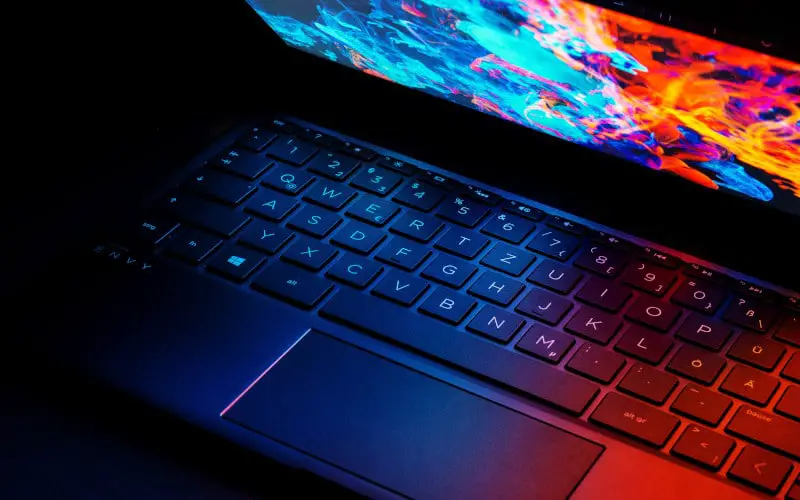It’s daunting to be unable to access a laptop when the primary navigational tool – the cursor – isn’t functioning. There are usually quick fixes for getting your laptop’s touchpad back up and running.
In this article, I will review some of the most common causes and how to troubleshoot them.
Why Touchpad Is Not Working In HP Laptop?
Hardware Issues
One of the first things to check when your touchpad is not working is whether or not there is a hardware issue. Here are a few things to consider:
Physical Damage
If your touchpad is physically damaged, it may not function correctly. This could be due to spills, drops, or other physical trauma. If you suspect your touchpad has been damaged, you’ll need to replace it to get it working again.
Loose Connections
Sometimes, the touchpad may not work correctly if its connections are loose. This could be due to a loose ribbon cable or a loose connection to the motherboard. You’ll need to inspect the connections to troubleshoot this issue and ensure everything is secure.
Touchpad Replacement
If you’ve determined that the touchpad is the issue, you’ll need to replace it to get it functioning again. Depending on your model laptop, this may require some technical expertise. You can often find replacement touchpads online, but it’s important to ensure you get the correct one for your specific laptop model.
Software Issues
If you’ve checked for hardware issues and everything seems to be in good working order, the next thing to consider is whether there might be a software issue causing your touchpad to malfunction. Here are a few common software-related problems that can cause touchpad issues:
Outdated Drivers
One of the most common reasons for touchpad issues is outdated drivers. Drivers are software programs that allow your computer to communicate with the hardware components of your laptop, including the touchpad. If the drivers for your touchpad are outdated, it may not function properly.
To check for and update your touchpad drivers, follow these steps:
- Open the Start menu and search for “Device Manager.“
- In the Device Manager, click on the arrow next to “Mice and other pointing devices.”
- Right-click on your touchpad and select “Update Driver.”
- Follow the prompts to update the driver.
Incorrect Settings
Sometimes, touchpad issues can be caused by incorrect settings. For example, the touchpad may be disabled in the device settings, or the sensitivity may be too low.
To check and adjust your touchpad settings, follow these steps:
- Open the Start menu and search for “Control Panel.“
- Search the Control Panel for “Touchpad” or “Mouse.”
- Click on the “Mouse” or “Touchpad” settings to open the settings window.
- Ensure the touchpad is enabled, and adjust any other settings as needed.
Virus or Malware
Viruses and malware can sometimes cause touchpad issues, as they can interfere with the functioning of the touchpad drivers. If you suspect that a virus or malware is causing your touchpad issues, you’ll need to run a scan and remove any threats. You can use a reputable antivirus program to do this.
Other Considerations
There are a few other things to consider if your touchpad is not working on your HP laptop:
External Mouse
If you’re having touchpad issues, you may be able to temporarily resolve them by using an external mouse. This can be a good way to troubleshoot the issue, as it will help you determine whether the problem is with the touchpad itself or something else.
BIOS Update
Sometimes, touchpad issues can be resolved by updating your laptop’s BIOS (Basic Input/Output System). The BIOS is a type of software that controls the hardware components of your laptop, including the touchpad.
To update the BIOS, you’ll need to download the latest version from the HP website and follow the prompts to install it.
Factory Reset
If you’ve tried all of the above troubleshooting steps and your touchpad is still not working, you may need to consider a factory reset. This will erase all of the data on your laptop and restore it to the original factory settings.
It’s important to back up any important files before a factory reset, as they will be deleted.
Conclusion
If your touchpad is not working on your HP laptop, there are a variety of potential causes and solutions. You can take steps to troubleshoot and fix hardware issues to software problems. If you’re still having trouble after trying these solutions, it may be a good idea to seek the help of a professional or contact HP support for further assistance.
Frequently Asked Questions
Why is my touchpad not working after a Windows update?
Sometimes, touchpad issues can occur after a Windows update. This is often due to outdated or incompatible drivers. To fix this issue, you’ll need to update the touchpad drivers. Follow the steps outlined in the “Outdated Drivers” section above.
How do I clean my touchpad?
If your touchpad is not functioning correctly and you suspect it may be dirty or sticky, you may be able to clean it to resolve the issue.
Here’s how:
- Please turn off your laptop and unplug it.
- Use a soft, dry cloth to gently wipe away any dirt or debris from the touchpad surface.
- If the touchpad is particularly dirty or sticky, you can use a small amount of rubbing alcohol on a cloth to clean it gently. Be sure to use a minimal amount and not let any liquid get inside the laptop.
- Once you’ve finished cleaning the touchpad, allow it to dry completely before turning your laptop back on.
My touchpad is working, but the cursor is moving erratically. What can I do?
If your touchpad is working, but the cursor is moving erratically, it may be due to a problem with the touchpad’s sensitivity.
To adjust the touchpad sensitivity, follow these steps:
- Open the Start menu and search for “Control Panel.“
- Search the Control Panel for “Touchpad” or “Mouse.”
- Click on the “Mouse” or “Touchpad” settings to open the settings window.
- Adjust the touchpad sensitivity settings as needed. You may also be able to disable or enable certain touchpad gestures, such as two-finger scrolling, in this window.
If adjusting the sensitivity and gestures doesn’t help, the touchpad may have a hardware issue. In this case, you may need to replace the touchpad or seek the help of a professional.







